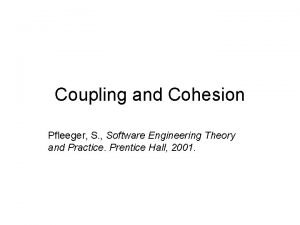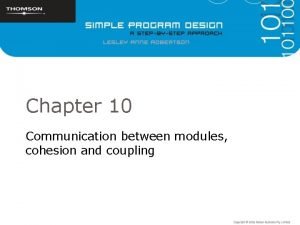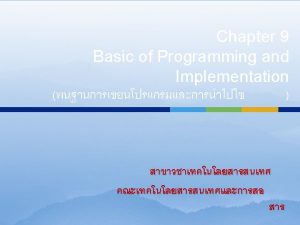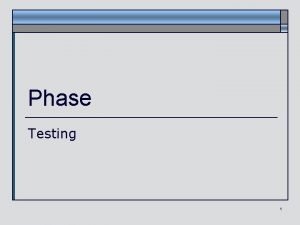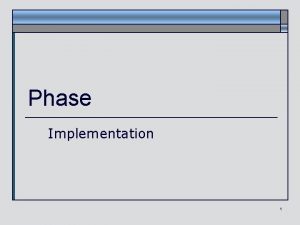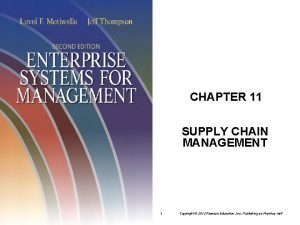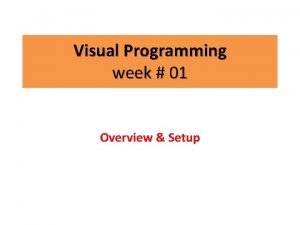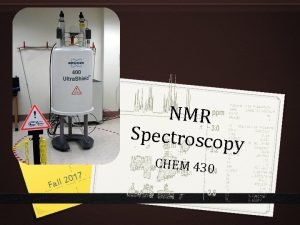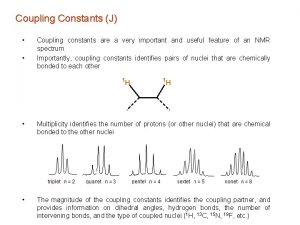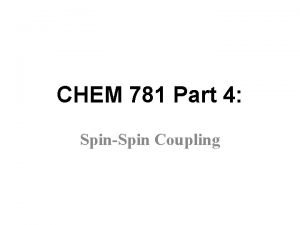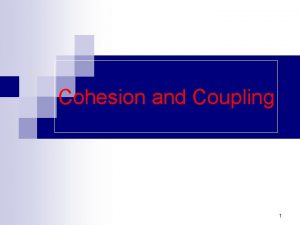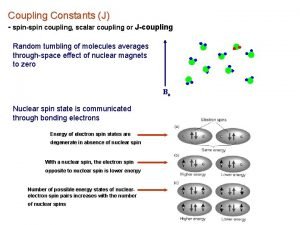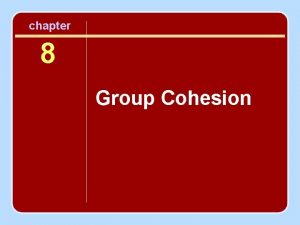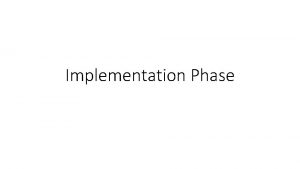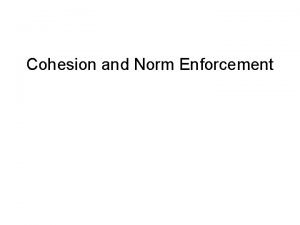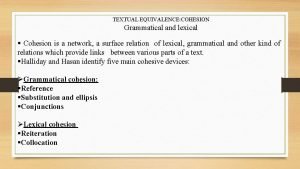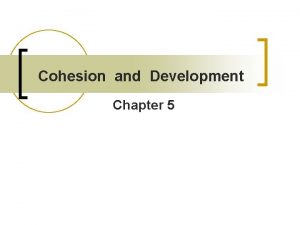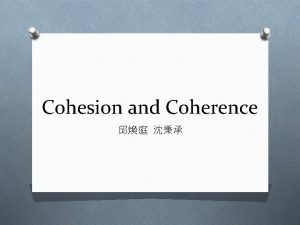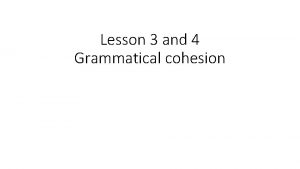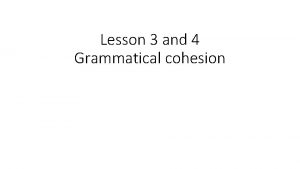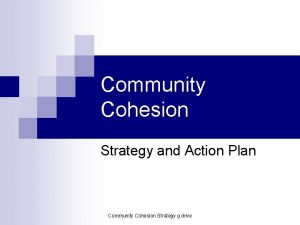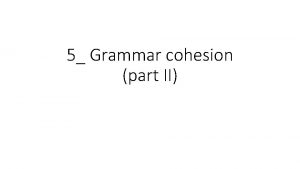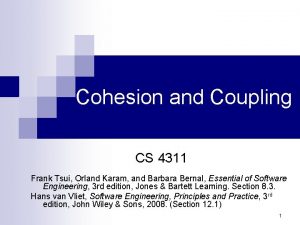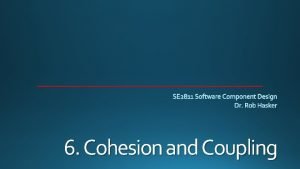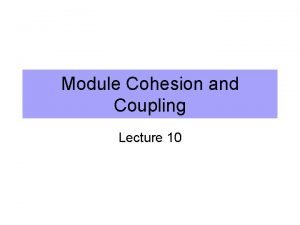Outline Programming Or Implementation Phase Cohesion and Coupling


























- Slides: 26


Outline ¥ Programming Or Implementation Phase ¥ Cohesion and Coupling ¥ The Modules and The Functions ¥ The rules for designing modules ¥ Types of modules 2


Programming Or Implementation Phase ¥ ¥ Transcribing the logical flow of solution steps in flowchart or algorithm to program code and run the program code on a computer using a programming language. Programming phase takes 5 stages: Coding. ¥ Compiling. ¥ Debugging. ¥ Run or Testing. ¥ Documentation and maintenance. ¥ 4

Programming Or Implementation Phase ¥ 5 Once the program is coded using one of the programming language, it will be compiled to ensure there is no syntax error. Syntax free program will then be executed to produce output and subsequently maintained and documented for later reference.

ขนตอนการเขยนโปรแกรม CODING COMPILE THE PROGRAM NO SYNTAX ERROR EXECUTE OR RUN 6 DOCUMENTATION OR MAINTENANCE MAKE CORRECTION

Programming Or Implementation Phase ¥ Coding ¥ ¥ ¥ Translation or conversion of each operation in the flowchart or algorithm (pseudocode) into a computerunderstandable language. Coding should follow the format of the chosen programming language. Many types or levels of computer programming language such as: ¥ ¥ 7 Machine language Symbolic language or assembly language Procedure-oriented language The first two languages are also called low-level programming language. While the last one is called high-level programming language.

Programming Or Implementation Phase ¥ Machine Language ¥ ¥ Machine language uses number to represent letters, alphabets or special character that are used to represent bit pattern. Example: ¥ an instruction to add regular pay to overtime pay, yielding total pay might be written in machine language as follows: 16 128 64 8 ¥ 8 in which 16 is a code that mean ADD to the computer. The 128 and 64 are addresses or location at which regular pay and overtime pay are stored. The 8 represents the storage location for the total pay.

Programming Or Implementation Phase ¥ Sometimes, bit pattern that represent letters and alphabets are used for coding. ¥ Example: Instead of: Use: ¥ 9 16 128 64 8 10000000 1000 This representation is ideal for a computer but difficult and tedious to the programmer to write a lengthy program.

Programming Or Implementation Phase ¥ Symbolic Language or Assembly Language ¥ ¥ ¥ A symbolic language or assembly language is closely related to machine language in that, one symbolic instruction will translate into one machine-language instruction. Contain fewer symbols, and these symbols may be letters and special characters, as well as numbers. As example, a machine language instruction 16 128 64 8 can be rewritten in assembly language as ADD LOC 1 LOC 2 LOC 3 ¥ 10 Which means, add content of location LOC 1 to location LOC 2 and put the result in location LOC 3.

Programming Or Implementation Phase ¥ Procedure – Oriented Language ¥ ¥ ¥ 11 Programmer has to know the computer hardware before he can write program in machine and assembly language. It means the language is machine dependent. Using procedure – oriented language, the programmer can run the program in any computer hardware. A special program called a compiler will translate program written using procedure – oriented language to machine language.

Programming Or Implementation Phase ¥ Some example of the language: ¥ COBOL (COmmon Business Oriented Language) FORTRAN (FORmula TRANslation) Pascal (Delphi), C, C++, BASIC, ¥ Java, Perl, Python, PHP, Prolog, … ¥ ¥ 12 These languages are also called high-level programming language Otherwise low-level programming : machine language, assembly

Programming Or Implementation Phase Computer Language Instruction Format Machine language Assembly language BASIC FORTRAN COBOL Pascal C 13 16 128 64 8 ADD LOC 1 LOC 2 LOC 3 LET T = R + 0 TOTAL = RPAY + OPAY ADD RPAY, OPAY GIVING TOTAL : = RPAY + OPAY TOTAL = RPAY + OPAY

Programming Or Implementation Phase ¥ Compiling and Debugging ¥ ¥ 14 Compiling is a process of a compiler translates a program written in a particular high–level programming language into a form that the computer can execute. The compiler will check the program code known also as source code so that any part of the source code that does not follow the format or any other language requirements will be flagged as syntax error. This syntax error in also called bug, when error is found, the programmer will debug or correct the error and then recompile the source code again. The debugging process is continued until there is no more error in the program.

Programming Or Implementation Phase ¥ Testing ¥ ¥ 15 The program code that contains no more error is called executable program. It is ready to be tested. When it is tested, the data is given and the result is verified so that it should produced output as intended. Though the program is error free, sometimes it does not produced the right result. In this case the program faces logic error. Incorrect sequence of instruction is an example that causes logic error.

Programming Or Implementation Phase ¥ Documentation and Maintenance ¥ ¥ ¥ 16 When the program is thoroughly tested for a substantial period of time and it is consistently producing the right output, it can be documented. Documentation is important for future reference. Other programmer may take over the operation of the program and the best way to understand a program is by studying the documentation. Trying to understand the logic of the program by looking at the source code is not a good approach. Studying the documentation is necessary when the program is subjected to enhancement or modification. Documentation is also necessary for management use as well as audit purposes.

Cohesion and Coupling )การทำงานรวมกนและใชงานคกน ¥ ¥ ¥ 17 ( Especially important concepts to the modern programmer, who in all probability will be working with many other programmers on the same problem. Cohesion allows a programmer to write a module of a large program and test it independently. Coupling allows all programmers to use necessary variables without losing the cohesion.

Cohesion ¥ Cohesion relates to the functional independence of the module and to the performance of a single task within the module. ¥ The objective is to separate the problem into parts. ¥ Each module is independent of each other module, with single entrance and a single exit, such as entering data, printing data, initialising data. 18

Coupling ¥ ¥ Coupling allows modules to be connected by an interface, which enables the programmer to transfer data from one module to another. Three coupling techniques are: ¥ ¥ ¥ 19 Parameter Modules names Global variables. Allows for communication between modules. Coupling allows all programmers to use necessary variable without losing the cohesion of the module.

Cohesion and Coupling Cohesion is the ability for each module to be independent of other modules. Module 2 Module 1 Coupling allows modules to share data 20 Module 3 Module 4

The Modules and The Functions ¥ The programmer breaks the problem into modules, each with specific function. ¥ It is much easier to write and test many small modules than a single large program. ¥ Modules are arranged according to processing order in interactivity chart. 21

The rules for designing modules 1. 2. 3. 4. 5. 22 Each module is an entity and has one entrance and one exit. Each module has a single function such as printing, calculating or entering data. Each module is short enough to be easily read and modified. The length of module governed by its function and the number of instruction to be executed. A module is developed to control the order of processing.

Types of modules 1. 2. 3. Control module • Show the overall flow of data through the program. All other modules are subordinate to it. Init module • Also called the preparation module, process instruction that are executed only once – at the beginning. Process Data module • May be processed only once, or may be part of a loop. 1. 23 Calculation Modules • Do arithmetic calculations.

Types of modules 2. 3. Print Modules • Print output lines. Read and Data validation modules • Read or input data, validate data • Validation modules separate from read modules Wrap-up module • Execute only once at the end. • Include closing file and printing totals. Event module • Such as mouse down, mouse up, key entry. 4. 5. 24

Question/Answer 25

Reference ¥ Maureen Sprankle - Problem Solving and Programming Concepts (9 th Edition) , Prentice Hall. , 2012 26
 Example of cohesion and coupling in software engineering
Example of cohesion and coupling in software engineering Coupling in communication
Coupling in communication Cohesion in programming
Cohesion in programming Implementation phase definition
Implementation phase definition Test plan document
Test plan document System development life cycle
System development life cycle Mobile phase and stationary phase
Mobile phase and stationary phase Mobile phase and stationary phase
Mobile phase and stationary phase Adsorption chromatography
Adsorption chromatography Citation sandwich example
Citation sandwich example Normal phase vs reverse phase chromatography
Normal phase vs reverse phase chromatography M tswett pronunciation
M tswett pronunciation Normal phase vs reverse phase chromatography
Normal phase vs reverse phase chromatography Line vs phase voltage
Line vs phase voltage In a ∆-connected source feeding a y-connected load
In a ∆-connected source feeding a y-connected load Broad phase vs narrow phase
Broad phase vs narrow phase Solution outline phase
Solution outline phase Ai2.appinventor.mit.edu emulator
Ai2.appinventor.mit.edu emulator Perbedaan linear programming dan integer programming
Perbedaan linear programming dan integer programming Greedy algorithm vs dynamic programming
Greedy algorithm vs dynamic programming Definition of system programming
Definition of system programming Linear vs integer programming
Linear vs integer programming Definisi linear
Definisi linear Nuclear spin quantum number
Nuclear spin quantum number Geminal coupling
Geminal coupling J coupling constant
J coupling constant Geminal and vicinal coupling constants
Geminal and vicinal coupling constants
